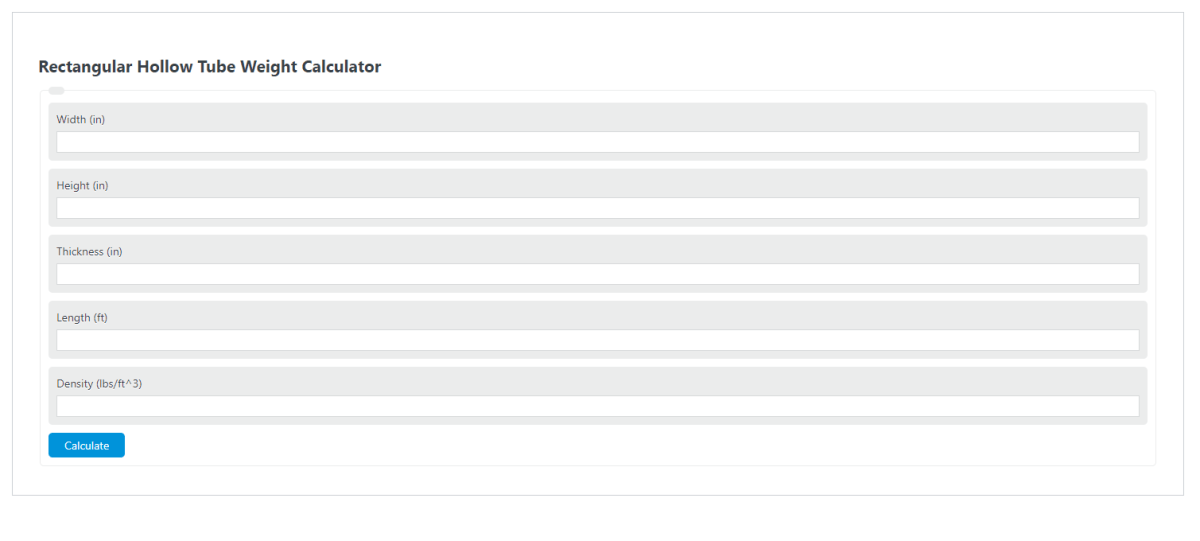Enter the width, height, thickness, length, and density of the rectangular hollow tube to calculate the weight.
- Weight of Tube Calculator
- Steel Bar Weight Per Foot Calculator
- Tube Bend Radius Calculator
- Linear Density Calculator
- Steel Tank Calculator
- Boulder Weight Calculator
- Titanium Pipe Weight Calculator
- PTFE Rod Weight Calculator
- Outer Radius of a Hollow Tube Calculator
Rectangular Hollow Tube Weight Formula
The following formula is used to calculate the weight of a Rectangular Hollow Tube.
W = (H*W - (W-t * H-t))*L*D
- Where W is the Rectangular Hollow Tube Weight (lbs)
- H is the height of the tube (in)
- W is the width of the tube (in)
- t is the thickness of the tube wall (in)
- L is the length of the tube (ft)
- D is the density of the tube (lbs/ft^3)
To calculate the weight of a hollow rectangular tube, subtract the inner volume from the total volume, then multiply the result by the density.
What is the weight of a Rectangular Hollow Tube?
The weight of a hollowed-out tube is equal to the total weight of the rectangular tube minus the weight of the inside hollow portion of the tube (if it is solid).
How to calculate Rectangular Hollow Tube Weight?
Example Problem:
The following example outlines how to calculate the Rectangular Hollow Tube Weight.
First, determine the width of the tube. In this case, the width is 5 inches.
Next, determine the height of the tube. For this example, the height is measured to be 3 inches.
Next, determine the wall thickness. This is measured to be .50 inches.
Next, determine the length of the tube. The length is measured to be 10 ft.
Next, determine the density of the material the tube is made from. This tube has a density of 500lbs/ft^3.
Finally, calculate the Rectangular Hollow Tube Weight using the formula above:
W = (H*W – (W-t * H-t))*L*D
W = (((5/12*(3/12))- ((5/12-.5/12) * (3/12-.5/12)))*10*500
W = 1562.5
FAQ
What is the significance of the Hollow Shaft Diameter Ratio in engineering applications?
The Hollow Shaft Diameter Ratio (HSDR) is crucial in engineering because it directly influences the shaft’s strength, weight, and overall performance. A higher HSDR means a thinner wall thickness, which can reduce weight but may also decrease structural integrity. Engineers use this ratio to design shafts that balance these factors according to the specific requirements of their applications, such as in automotive, aerospace, and construction industries.
How does changing the inner or outer diameter affect the HSDR?
Changing the inner diameter (ID) or the outer diameter (OD) directly affects the HSDR. Increasing the ID while keeping the OD constant will increase the HSDR, indicating a thinner wall and potentially less strength. Conversely, increasing the OD while keeping the ID constant will decrease the HSDR, indicating a thicker wall which could mean more weight but increased strength. Adjusting these diameters allows for the customization of the shaft’s properties for its intended use.
Can the Hollow Shaft Diameter Ratio be used to calculate the weight of the shaft?
While the HSDR itself does not directly provide the weight of the shaft, it is an essential factor in calculating weight. Knowing the inner and outer diameters (and thus the HSDR) allows for the determination of the shaft’s volume. With the material density, the volume can then be used to calculate the weight. This calculation is crucial for applications where weight plays a significant role in the design and functionality of the shaft, such as in aerospace or automotive engineering.
